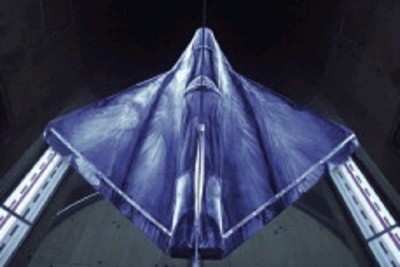Wed, Sep 09, 2009
Future Engineers Prepare To Test Future UAS
 Engineering apprentices at BAE
Systems are adding the final touches to an experimental aircraft
that will test radical new methods of controlling it in flight.
Engineering apprentices at BAE
Systems are adding the final touches to an experimental aircraft
that will test radical new methods of controlling it in flight.
The demonstrator has been built under a project to explore
technologies destined for use on future unmanned aircraft systems
(UAS). Known as Demon, the aircraft is the outcome of a project
called FLAVIIR (Flapless Air Vehicle Integrated Industrial
Research). This five-year program costing nearly $11 million is
jointly funded by BAE Systems and the Engineering and Physical
Sciences Research Council (EPSRC).
FLAVIIR brings together 10 universities, led by Cranfield
University and BAE Systems. Its major focus is to develop the
technologies needed to build a low-cost, low maintenance UAS with
no conventional control surfaces, such as wing flaps and without
losing any performance compared to conventional aircraft.
Matt Pearson, Demon Delivery Manager, said the aircraft is a 176
pound, jet-powered UAS with a wing span of about 8 feet. It was
designed at Cranfield University, with the support of the other
partner institutions, and manufacture and assembly has been carried
out jointly by Cranfield's Composite Manufacturing Center and BAE
Systems apprentices.

BAE Demon Photo Courtesy BAE
Systems
Matt described the apprentices working on Demon as the
"engineers of the future, working on the technology of the future".
He said they had taken the air frame, fitted it out, and added all
the wiring and electrical systems needed to create a working,
functioning aircraft. Now in the final stages of assembly, Demon
will make its first test flights later this year. The project has
developed a number of ways of doing away with flaps and the flight
tests will evaluate which of these is best.
Richard Williams, Program Director Future Capability, is
delighted with the Demon's progress: "Projects such as Demon have
several advantages for BAE Systems. "They help to ensure we get the
greatest benefit from our invested research money and offer
continued benefit from the increase in the capability and
competencies of the universities involved."
More News
Pilot Also Reported That Due To A Fuel Leak, The Auxiliary Fuel Tanks Were Not Used On June 4, 2025, at 13:41 eastern daylight time, a Piper PA-23, N2109P, was substantially damage>[...]
Have A Story That NEEDS To Be Featured On Aero-News? Here’s How To Submit A Story To Our Team Some of the greatest new stories ANN has ever covered have been submitted by our>[...]
From 2023 (YouTube Edition): Reflections on War’s Collective Lessons and Cyclical Nature The exigencies of war ought be colorblind. Inane social-constructs the likes of racis>[...]
Aero Linx: Colorado Pilots Association (CPA) Colorado Pilots Association was incorporated as a Colorado Nonprofit Corporation in 1972. It is a statewide organization with over 700 >[...]
High Speed Taxiway A long radius taxiway designed and provided with lighting or marking to define the path of aircraft, traveling at high speed (up to 60 knots), from the runway ce>[...]
 NTSB Prelim: Piper PA-23
NTSB Prelim: Piper PA-23 ANN FAQ: Submit a News Story!
ANN FAQ: Submit a News Story! Classic Aero-TV: One Mans Vietnam
Classic Aero-TV: One Mans Vietnam ANN's Daily Aero-Linx (07.03.25)
ANN's Daily Aero-Linx (07.03.25) ANN's Daily Aero-Term (07.03.25): High Speed Taxiway
ANN's Daily Aero-Term (07.03.25): High Speed Taxiway



